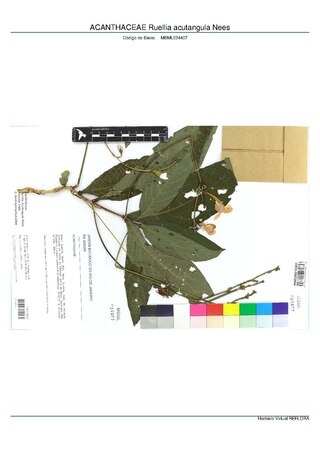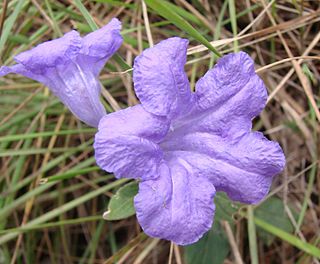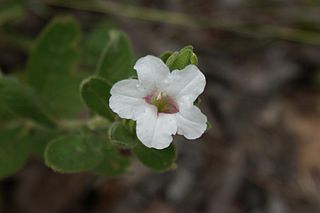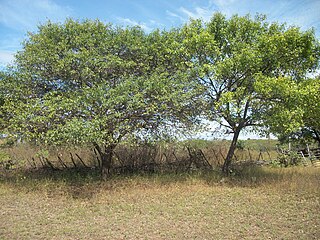
Acanthaceae is a family of dicotyledonous flowering plants containing almost 250 genera and about 2500 species. Most are tropical herbs, shrubs, or twining vines; some are epiphytes. Only a few species are distributed in temperate regions. The four main centres of distribution are Indonesia and Malaysia, Africa, Brazil, and Central America. Representatives of the family can be found in nearly every habitat, including dense or open forests, scrublands, wet fields and valleys, sea coast and marine areas, swamps, and mangrove forests.

Ruellia is a genus of flowering plants commonly known as ruellias or wild petunias. They are not closely related to petunias (Petunia) although both genera belong to the same euasterid clade. The genus was named in honor of Jean Ruelle (1474–1537), herbalist and physician to Francis I of France and translator of several works of Dioscorides.

Ruellia acutangula is a plant native to the Cerrado vegetation of Brazil.
Ruellia verbasciformis is a species of flowering plant native to the Cerrado vegetation of Brazil. It is endemic to west-central Brazil. This plant is cited in Flora Brasiliensis by Carl Friedrich Philipp von Martius.

Ruellia simplex, the Mexican petunia, Mexican bluebell or Britton's wild petunia, is a species of flowering plant in the family Acanthaceae. It is a native of Mexico, the Caribbean, and South America. It has become a widespread invasive plant in Florida, where it was likely introduced as an ornamental before 1933, as well as in the eastern Mediterranean, South Asia and other parts of the eastern hemisphere.
Ruellia brevicaulis is a species of flowering plant native to Argentina, Brazil, and Paraguay. It is native to the Cerrado vegetation of Brazil.

Ruellia geminiflora, known locally as ipecacuanha-da-flor-roxa, is a species native to Argentina; Brazil, typically Caatinga and Cerrado vegetation; Guianas, and Venezuela. The roots of this plant contains possibly toxic substances.
Ruellia dissitifolia is a species of flowering plant in the family Acanthaceae. It is native to the Cerrado ecoregion of Brazil.
Ruellia pohlii is a plant native to the Cerrado vegetation of Brazil. This plant is cited in Flora Brasiliensis by Carl Friedrich Philipp von Martius.

Ruellia nitens is a species of flowering plant native to the Cerrado vegetation of central and northeastern Brazil. This plant is cited in Flora Brasiliensis by Carl Friedrich Philipp von Martius.

Ruellia macrantha, or Christmas pride, is a species of flowering plant native to the cerrado vegetation of Brazil. It is often used as an ornamental plant. This plant is cited in Flora Brasiliensis by Carl Friedrich Philipp von Martius.
Ruellia angustior is a plant native of Cerrado vegetation of western Brazil. This plant is cited in Flora Brasiliensis by Carl Friedrich Philipp von Martius.

Aspidosperma pyrifolium, synonym Aspidosperma populifolium, is a tree native to Brazil and Paraguay, which is typical of Caatinga vegetation. In addition, it is useful for beekeeping. It was first described by Carl Friedrich Philipp von Martius in 1824.

Caatinga is a type of semi-arid tropical vegetation, and an ecoregion characterized by this vegetation in interior northeastern Brazil. The name "Caatinga" is a Tupi word meaning "white forest" or "white vegetation" . The Caatinga is a xeric shrubland and thorn forest, which consists primarily of small, thorny trees that shed their leaves seasonally. Cacti, thick-stemmed plants, thorny brush, and arid-adapted grasses make up the ground layer. Most vegetation experiences a brief burst of activity during the three-month long rainy season.
Xyris asperula is an uncommon South American species of flowering plants in the yellow-eyed-grass family. It has been found in Bolivia and also in the States of Goiás and Minas Gerais in Brazil.








